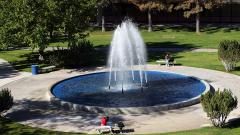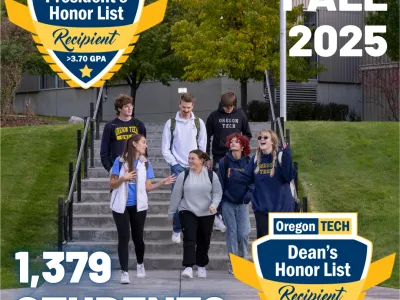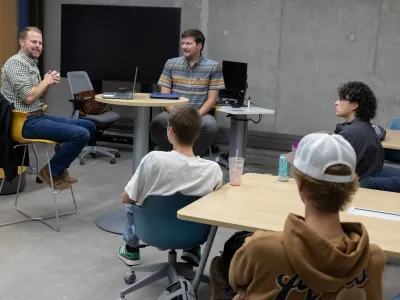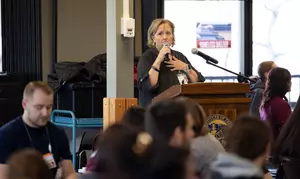
instructions to students before the simulation
About 100 people experienced the very real challenges associated with poverty in a unique simulation conducted Feb. 1 by the Oregon Health & Science University (OHSU) School of Nursing’s Klamath Falls campus, which is co-located at Oregon Tech.
The Community Action Poverty Simulation (CAPS) was designed to help people who frequently work with low-income families better understand the realities of poverty, as well as to create a broader awareness of poverty among policymakers, community leaders, and others. Participants included OHSU and Klamath Community College (KCC) nursing students, Oregon Tech allied health students, and Klamath Falls community partners and agencies.
“This simulation helps our students understand the complexities and frustrations of living in poverty day-to-day,” said event organizer and OHSU Simulation Coordinator Lauri Gimpel. “With greater awareness of its impact, our students can more effectively address the poverty issues faced by their patients and clients in our community. Our hope is that all participants will remember how they felt simulating living a month in poverty and direct those feelings toward positive action in their communities.”
Using a simulation kit, participants role-played various obstacles low-income families may encounter. Some were Temporary Assistance for Needy Families recipients, some were disabled, and others were senior citizens on Social Security. Participants were expected to navigate acquiring basic necessities and shelter on a limited budget during the course of four 15-minute “weeks.”
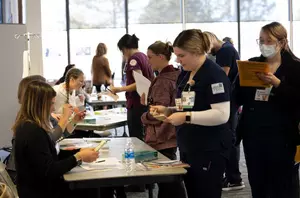
OHSU Nursing senior Grace Hull navigated the system as an 85-year-old single male living on Social Security.
“This poverty simulation is important for public health and nursing professions to see the other side of care so we can provide resources that will actually help our patients,” Hull said.
Participants interacted with human service agencies, grocers, pawnbrokers, bill collectors, job interviewers, police officers, and others to meet their predetermined needs.
OHSU Nursing junior Jaedyn DeForrest worked within a “family unit” to meet her needs. “This allows nursing students to see the lifestyle their patients might be experiencing and find local resources to help them,” DeForrest said.
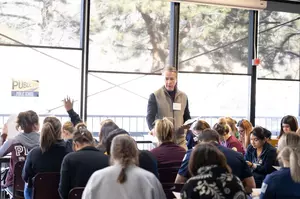
to run the public school for the simulation
Simulation volunteers operated mock service tables representing community resource agencies participants were required to visit, including a grocery store; school, where children in the family sat for 8 minutes of their 15-minute “week”; social services; a pawn shop; healthcare; bank; community action agency; and so on. Participants whose persona had a job also had to report to work for 7 minutes of their 15-minute week, in addition to trying to complete all the other tasks they were given for that segment.
The addition of the poverty simulation to the healthcare curriculum helps students rethink the challenges millions of low-income individuals face daily. More importantly, this tool helps them identify areas of change that can directly impact the effects of poverty on individuals, families, and communities.
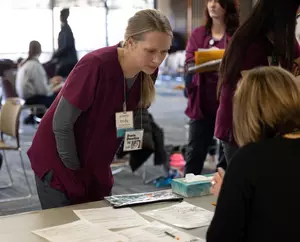
during the simulation
Allison Sansom, KCC Dean of Nursing, Health, and Science, shared that KCC was grateful to the OSHU School of Nursing for organizing this meaningful event and for inviting KCC students to participate. “This is a great example of how our nursing programs are working together to sustain and expand the excellent health services our community needs,” she said. “Poverty is a reality that unfortunately many in our community experience and, unless one has experienced it themselves, they can’t fully comprehend the effects.”
According to 2022 census estimates, more than 508,800 people in Oregon are living at or below the federal poverty level, and in Klamath County, 19.1% of families live in poverty.
“Simulations provide real-life experience to offer our students a greater understanding of the experience of living in poverty and how that impacts one’s overall health,” Sansom said.
The Missouri Association for Community Action made the simulation available nationwide. It is a network of community action agencies throughout the state that provide a variety of services to low-income individuals and families. Please visit their website at www.communityaction.org to find out more about the poverty simulation.
###




